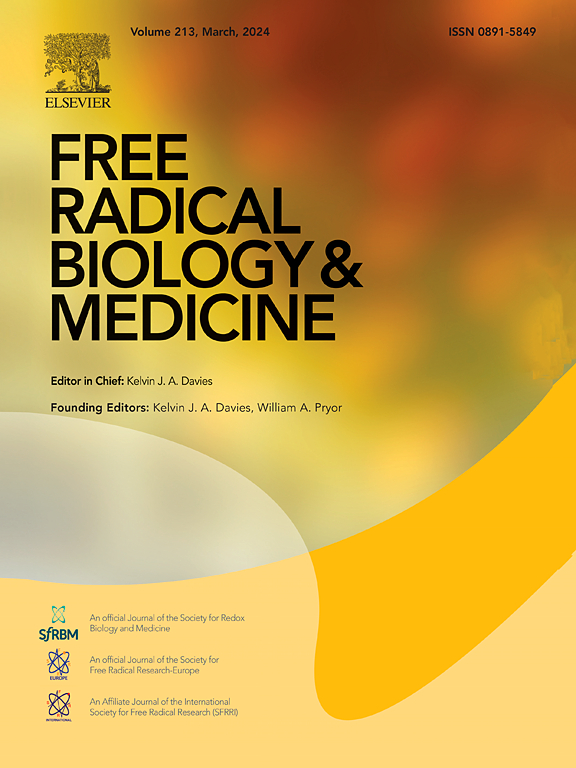烟酰胺单核苷酸通过gpx4介导的肺泡上皮细胞抗铁凋亡信号通路减轻高氧加重的脓毒性肺损伤
IF 7.1
2区 生物学
Q1 BIOCHEMISTRY & MOLECULAR BIOLOGY
引用次数: 0
摘要
高氧加重脓毒性肺损伤的分子机制和最佳治疗策略尚不清楚。探讨烟酰胺单核苷酸(NMN)对高氧加重脓毒性肺损伤的作用及其机制。方法建立脓毒症致肺损伤大鼠模型和细胞模型,进行高氧处理,然后分别给予NMN、铁下沉启动子和抑制剂。根据组织学检查、肺组织损伤评分、肺组织湿/干重比、氧合指数、TNF- α和IL-6水平、细胞活力评估肺损伤程度。同时,采用多种方法评价上睑下垂。免疫组化法检测肺组织中谷胱甘肽过氧化物酶4 (GPx4)和4-羟基壬烯醛(4- hne)水平,普鲁士蓝染色法检测铁沉积。用相应的试剂盒检测Fe2+、MDA和GSH水平。采用流式细胞术和免疫荧光技术检测活性氧(ROS)水平。同时检测GPx4和ACSL4的蛋白和mRNA水平。通过使用SIRT6抑制剂和激活剂,以及与sh-GPx4联合,明确sirtuin 6 (SIRT6)与GPx4的关系。结果缺氧加重盲肠结扎穿刺(CLP)大鼠肺损伤。在脂多糖(LPS)模型中,高氧也会加剧对肺泡上皮细胞(AECs)的损伤。然而,NMN改善了这些有害影响。此外,LPS +高氧处理显著上调Fe2+、MDA、ROS和ACSL4水平,加重氧化损伤。此外,LPS +高氧处理下调GSH和GPx4水平,从而降低抗氧化能力。此外,铁凋亡启动子Erastin进一步加剧了氧化应激损伤和炎症反应。然而,铁下垂抑制剂Fer-1减轻了这种损害。同样,NMN抑制高氧加重脓毒性肺损伤的铁下垂。NMN和sh-GPx4联合治疗可逆转NMN对lps刺激的aec高氧损伤的保护作用。补充NMN增加了aec中SIRT6的表达。SIRT6的抑制降低了GPx4的表达,提高了铁下垂标志物,而SIRT6的激活则有相反的作用。SIRT6激活剂和sh-GPx4共同处理逆转了对铁下垂的抑制作用。结论高氧通过诱导aec铁下垂加重脓毒性肺损伤。NMN通过上调SIRT6,抑制aec铁上吊,从而上调GPx4,减轻高氧加重的脓毒性肺损伤。本文章由计算机程序翻译,如有差异,请以英文原文为准。

Nicotinamide mononucleotide mitigates hyperoxia-aggravated septic lung injury via the GPx4-mediated anti-ferroptosis signaling pathway in alveolar epithelial cells
Background
The molecular mechanisms and optimal treatment strategies underlying hyperoxia-aggravated septic lung injury remain elusive. We explored the effects and mechanisms of nicotinamide mononucleotide (NMN) on hyperoxia-aggravated septic lung injury.
Methods
The rat and cellular models of sepsis-induced lung injury were established and subjected to hyperoxygenation treatment, followed by treatment with NMN, ferroptosis promoter, or inhibitor separately. The extent of lung injury was assessed based on histological examination, lung histological injury scores, wet/dry weight ratio of lung tissues, oxygenation indexes, TNF-ɑ and IL-6 levels, and cell viability. Meanwhile, ferroptosis was assessed through various methods. The levels of glutathione peroxidase 4 (GPx4) and 4-hydroxynonenal (4-HNE) in lung tissues were determined by immunohistochemistry, while iron deposition was evaluated using Prussian blue staining. Fe2+, MDA, and GSH levels were also detected with the respective kits. The reactive oxygen species (ROS) level was measured by flow cytometry and immunofluorescence techniques. The protein and mRNA levels of GPx4 and ACSL4 were also detected. The relationship between sirtuin 6 (SIRT6) and GPx4 was clarified by using SIRT6 inhibitor and activator, as well as in combination with sh-GPx4.
Results
Hyperoxia exacerbated lung injury in rats subjected to cecal ligation and puncture (CLP). Hyperoxia also intensified damage to alveolar epithelial cells (AECs) in a lipopolysaccharide (LPS) model. However, NMN ameliorated these detrimental effects. Furthermore, LPS + Hyperoxia treatment significantly upregulated Fe2+, MDA, ROS, and ACSL4 levels, exacerbating oxidative damage. Also, LPS + Hyperoxia treatment downregulated GSH and GPx4 levels, thereby reducing antioxidant capacity. Additionally, Erastin, a ferroptosis promoter, further intensified oxidative stress damage and inflammatory response. However, ferroptosis inhibitor Fer-1 alleviated this damage. Similarly, NMN inhibited ferroptosis in hyperoxia-aggravated septic lung injury. Co-treatment with NMN and sh-GPx4 reversed the protective effect of NMN against LPS-stimulated injury exacerbated by hyperoxia in AECs. NMN supplementation increased SIRT6 expression in AECs. SIRT6 inhibition decreased GPx4 expression and raised ferroptosis markers, while SIRT6 activation had opposite effects. Co-treatment with SIRT6 activator and sh-GPx4 reversed the inhibitory effect on ferroptosis.
Conclusion
Hyperoxia aggravates septic lung injury by inducing ferroptosis of AECs. NMN can mitigate hyperoxia-aggravated septic lung injury by up-regulating GPx4 through increasing SIRT6 and inhibiting ferroptosis of AECs.
求助全文
通过发布文献求助,成功后即可免费获取论文全文。
去求助
来源期刊

Free Radical Biology and Medicine
医学-内分泌学与代谢
CiteScore
14.00
自引率
4.10%
发文量
850
审稿时长
22 days
期刊介绍:
Free Radical Biology and Medicine is a leading journal in the field of redox biology, which is the study of the role of reactive oxygen species (ROS) and other oxidizing agents in biological systems. The journal serves as a premier forum for publishing innovative and groundbreaking research that explores the redox biology of health and disease, covering a wide range of topics and disciplines. Free Radical Biology and Medicine also commissions Special Issues that highlight recent advances in both basic and clinical research, with a particular emphasis on the mechanisms underlying altered metabolism and redox signaling. These Special Issues aim to provide a focused platform for the latest research in the field, fostering collaboration and knowledge exchange among researchers and clinicians.
 求助内容:
求助内容: 应助结果提醒方式:
应助结果提醒方式:


